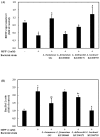Probiotic Properties and Neuroprotective Effects of Lactobacillus buchneri KU200793 Isolated from Korean Fermented Foods
- PMID: 32059401
- PMCID: PMC7072984
- DOI: 10.3390/ijms21041227
Probiotic Properties and Neuroprotective Effects of Lactobacillus buchneri KU200793 Isolated from Korean Fermented Foods
Abstract
The purpose of this study was to evaluate the probiotic characteristics and neuroprotective effects of bacteria isolated from Korean fermented foods. Three bacterial strains (Lactobacillus fermentum KU200060, Lactobacillus delbrueckii KU200171, and Lactobacillus buchneri KU200793) showed potential probiotic properties, such as high tolerance against artificial gastric juice and bile salts, sensitivity to antibiotics, nonproduction of carcinogenic enzymes, and high adhesion to intestinal cells. Heat-killed L. fermentum KU200060 and L. buchneri KU200793 showed higher antioxidant activity than heat-killed L. delbrueckii KU200171. The conditioned medium (CM) was used to evaluate the reaction between HT-29 cells and each heat-killed strain. All CMs protected SH-SY5Y cells from 1-methyl-4-phenylpyridinium (MPP+)-induced toxicity. The expression of brain-derived neurotropic factor (BDNF) mRNA in HT-29 cells treated with CM containing heat-killed L. buchneri KU200793 was the highest. The CM significantly reduced the Bax/Bcl-2 ratio and increased BDNF mRNA expression in SH-SY5Y cells treated with MPP+. These results indicate that L. buchneri KU200793 can be used as a prophylactic functional food, having probiotic potential and neuroprotective effects.
Keywords: Lactobacillus buchneri; gut-brain-axis; kimchi; neuroprotective effect; probiotics.
Conflict of interest statement
The authors declare no conflicts of interest.
Figures



References
MeSH terms
Substances
Supplementary concepts
LinkOut - more resources
Full Text Sources
Other Literature Sources
Molecular Biology Databases
Research Materials

